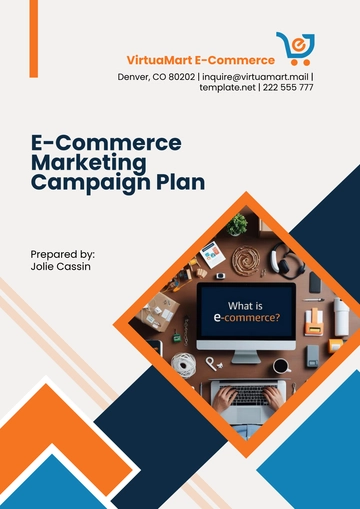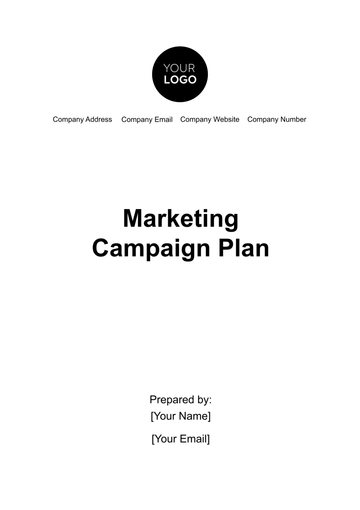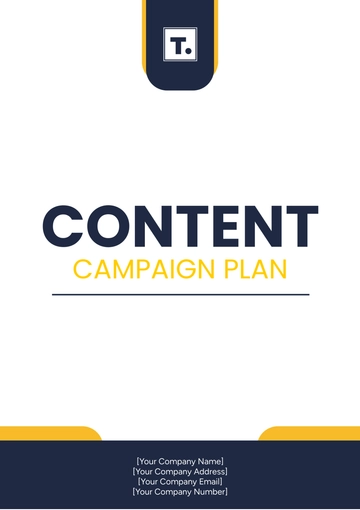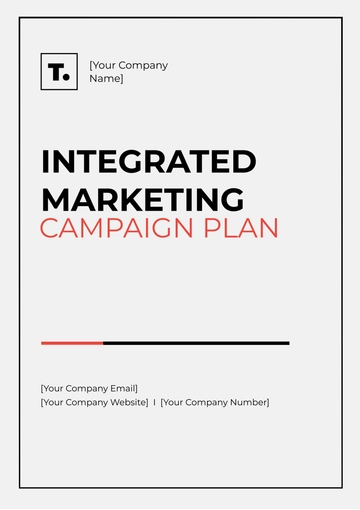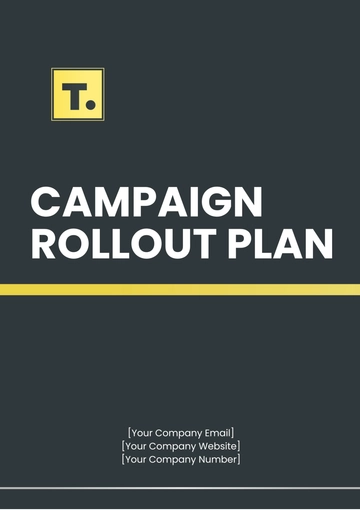Free E-Commerce Marketing Campaign Plan

I. Executive Summary
A. Campaign Overview
[Your Company Name]'s [Campaign Name] is a 4-week e-commerce campaign designed to attract shoppers during the peak holiday shopping season. The sale will feature discounts across a range of high-demand product categories, including electronics, home decor, and fashion accessories. The campaign aims to drive both new customer acquisition and repeat business from existing customers by offering limited-time promotions and exclusive deals.
B. Objectives and Goals
The primary goal is to increase total sales by [00]% during the campaign period compared to last year’s holiday sales. In addition, secondary goals include boosting website traffic by [00]%, increasing email list sign-ups by [00]%, and growing social media followers by [00]%. Achieving these targets will solidify the brand's position as a key player in the holiday shopping space.
C. Key Performance Indicators (KPIs)
KPIs include sales revenue, the conversion rate from website visits, and return on ad spend (ROAS) for paid campaigns. Additionally, we will track customer engagement on social media platforms and email open and click-through rates. These metrics will allow us to adjust the campaign in real-time for maximum efficiency.
D. Target Audience Summary
The target audience consists of tech-savvy online shoppers, aged 25-45, who appreciate high-quality products at competitive prices. These shoppers frequently use mobile devices for browsing and prefer shopping on platforms like Instagram and Facebook. By understanding their preferences, we aim to craft personalized marketing messages that resonate with their needs.
E. Budget Overview
The total campaign budget is set at $[00], allocated across paid media, content production, influencer partnerships, and promotional offers. This budget allows for the execution of a high-impact, multi-channel marketing strategy while maintaining cost-effectiveness. The goal is to ensure that every dollar spent contributes directly to achieving the campaign objectives.
II. Market Research and Analysis
A. Industry Trends
E-commerce is projected to grow by [00]% in 2050, with a significant portion of this increase coming from mobile shopping and personalized experiences. The trend of offering exclusive discounts and flash sales continues to drive customer behavior, especially during holiday seasons. Additionally, there is a growing emphasis on sustainability, with consumers increasingly seeking eco-friendly products and brands that promote social responsibility.
B. Competitive Analysis
Competitors such as [Competitor A] and [Competitor B] have successfully captured market share by offering aggressive discounts and leveraging influencer marketing. However, our unique advantage lies in our focus on delivering exclusive "early access" deals to our loyal customers through email campaigns. This personalized approach, coupled with a seamless mobile shopping experience, will give us an edge over competitors.
C. SWOT Analysis
Strengths | A well-established brand with loyal customers and high-quality products. We have a strong e-commerce platform that supports seamless transactions and efficient delivery. |
Weaknesses | Limited recognition in international markets, and shipping costs can sometimes be higher than those of competitors. |
Opportunities | Expanding into international markets with tailored campaigns, leveraging influencer partnerships to reach new customer segments. |
Threats | Intense competition during the holiday season, and potential shifts in consumer spending due to economic uncertainty. |
D. Customer Insights
Customer Personas
[Persona A], 30, a busy professional, loves online shopping for the latest fashion trends, and values quick delivery and easy returns.
[Persona B], 40, a tech enthusiast, is constantly on the lookout for new gadgets and is motivated by value-driven discounts and product reviews.
Behavioral Insights
[00]% of customers browse and purchase on mobile devices, and [00]% engage with social media content before making purchasing decisions.
Customers are highly responsive to time-sensitive offers, especially if they are perceived as exclusive or limited edition.
III. Campaign Objectives
A. Primary Objective
The main objective is to increase total sales by [00]% during the 4-week promotional period. This will be accomplished by offering strategic discounts, flash sales, and personalized product recommendations to drive customer purchases. Meeting this goal will position the brand for long-term growth in the competitive holiday market.
B. Secondary Objectives
Secondary goals include increasing website traffic by [00]% through a combination of paid advertising and organic SEO efforts. Additionally, we aim to grow the email subscriber list by [00]% by incentivizing sign-ups with exclusive deals and early access offers. These objectives will help build a strong customer base for sustained growth post-campaign.
C. SMART Goals
Specific: Achieve a [00]% increase in sales compared to last year’s holiday period.
Measurable: Track performance through Google Analytics and campaign reports to monitor sales, traffic, and engagement.
Achievable: Given the allocated budget and previous year’s performance, these targets are realistic.
Relevant: The goals align with the overall business growth strategy and brand positioning.
Time-bound: The campaign will run for 4 weeks, with progress reviewed weekly to make adjustments.
D. Milestones and Timeline
Pre-launch (Week 1) | Start with teasers on social media, email blast for early access subscribers, and influencer content. |
Launch (Week 2-3) | Begin the main sale with product highlights, daily promotions, and exclusive deals. |
Post-launch (Week 4) | Retarget customers who engaged but didn’t convert and send follow-up offers to keep the momentum going. |
IV. Target Audience
A. Demographic Profile
The target audience includes individuals aged 25-45, both men and women, with a middle-to-upper-middle-class income. They are urban dwellers, likely to have disposable income for discretionary spending during the holiday season. The audience is spread across the US, with plans to extend to Canada and the UK in future campaigns.
B. Psychographic Profile
The target audience values quality, convenience, and exclusivity in the products they purchase. They are digitally savvy, spending time on social media and regularly engaging with brands via Instagram, Facebook, and Pinterest. They tend to favor sustainable and ethical brands that align with their values.
C. Behavioral Characteristics
Frequent online shoppers, especially during promotional periods, and tend to purchase higher-ticket items when discounts are available.
Active on social media, often using platforms to discover new products, read reviews, and follow influencers.
Prefer brands that offer fast shipping and simple return policies, especially during the holiday season.
D. Customer Needs and Pain Points
Customers are seeking good deals without compromising on product quality.
They are looking for hassle-free shopping experiences, from easy navigation to swift delivery and returns.
E. Segmenting the Audience for Personalized Campaigns
Segment 1 | Early holiday shoppers who want to avoid last-minute stress and are interested in exclusive deals. |
Segment 2 | Last-minute shoppers looking for fast delivery options, eager to find discounts closer to Christmas. |
V. Marketing Channels and Tactics
A. Organic Marketing
SEO: Focus on optimizing product pages with high-traffic holiday keywords, such as “best Christmas gifts for tech lovers” and “holiday home decor deals.”
Content Marketing: Publish engaging blog posts on "Top Holiday Gifts" and “How to Choose the Best Tech Gadgets.” These will be shared across all channels to drive organic traffic.
Social Media Organic Reach: Post regular updates, countdowns, and behind-the-scenes footage on Instagram and Facebook to build excitement for the sale.
Influencer Partnerships: Partner with well-known influencers who align with the brand’s values to create authentic content around our top products.
B. Paid Marketing
Search Engine Marketing (Google Ads): Use highly-targeted ads for high-intent keywords, such as “buy [product] for Christmas,” ensuring visibility when customers are actively searching for holiday gifts.
Social Media Advertising: Run Instagram and Facebook ads featuring product highlights and limited-time offers. These will drive both awareness and conversions.
Display Ads and Retargeting: Implement display ads to re-engage users who have visited the site but did not complete a purchase, reminding them of the ongoing sale.
C. Email Marketing
Email List Segmentation: Create segments based on past purchase behavior, such as tech enthusiasts, fashion lovers, or home decor shoppers, and personalize messages for each group.
Campaign Types:
Pre-launch: "Get ready for exclusive deals!"
Launch: “Early access to our biggest sale of the year!”
Post-launch: “Thanks for shopping! Here’s a special offer just for you.”
Automation and Timing Strategy: Send cart abandonment emails 24 hours after a user leaves items behind, followed by an incentive to complete the purchase.
D. Affiliate and Partnership Marketing
Influencer Collaborations | Partner with influencers in the tech, lifestyle, and fashion spaces to showcase how they use or recommend the products we are offering. |
Affiliate Program | Activate an affiliate program offering commissions for influencers or bloggers who successfully refer customers during the campaign. |
VI. Creative Strategy and Content Plan
A. Creative Themes and Messaging
The creative theme for this campaign will focus on holiday cheer, with an emphasis on gifting, family, and exclusive offers. Messaging will highlight the value proposition of shopping with us, such as "Quality gifts at unbeatable prices" and "Limited-time offers you won’t find anywhere else." The tone will be festive, friendly, and urgent to evoke a sense of excitement and exclusivity.
B. Visual Assets and Design
The visuals will incorporate vibrant, seasonal colors like red, green, and gold, alongside imagery of holiday-related products and happy families. Product images will be styled to reflect their use in holiday settings, such as gadgets being opened on Christmas morning or fashion accessories paired with winter outfits. The designs will be optimized for mobile viewing to ensure they are impactful on all devices.
C. Content Formats
Content will be produced in various formats to cater to different platforms:
Static Posts for Instagram and Facebook with product highlights and countdowns.
Video Content for both organic and paid ads showcasing product demos, testimonials, and behind-the-scenes moments.
Email Newsletters with curated lists of best-selling items and personalized recommendations for subscribers.
D. Content Distribution Strategy
Content will be strategically released based on the campaign timeline:
Pre-launch (Week 1) | Teaser posts on social media and exclusive early access emails. |
Launch (Week 2-3) | Increased frequency of social media posts and video ads, coupled with email promotions highlighting time-sensitive offers. |
Post-launch (Week 4) | Continued engagement through retargeted ads and follow-up emails with special offers to drive final sales before the holidays. |
VII. Advertising Strategy
A. Paid Media Channels
Paid media will focus on Facebook, Instagram, Google Ads, and YouTube. These platforms are ideal for reaching the target demographic, particularly Instagram and Facebook, where our audience is most active. Google Ads will help us capture high-intent search traffic, and YouTube will allow for more engaging video content that can explain the benefits of our products in detail.
B. Ad Creatives
Ad creatives will feature dynamic and engaging content that highlights the holiday spirit and product benefits. Static ads will feature product close-ups with text overlays showcasing the discounts, while video ads will include happy customers using the products in festive settings. To further increase urgency, all ad creatives will feature countdown clocks to indicate the limited-time nature of the offers.
C. Budget Allocation for Paid Media
The paid media budget will be split as follows:
[00]% for Facebook and Instagram ads, focusing on brand awareness and engagement.
[00]% for Google Search and Display ads, targeting high-intent buyers.
[00]% for YouTube video ads, promoting special offers and new product releases.
[00]% for retargeting ads to bring back website visitors who didn’t convert during their first interaction.
D. Retargeting Strategy
Retargeting ads will be served to users who visited the site but didn’t complete their purchase, showing them the exact products they viewed. Additionally, we will set up dynamic retargeting ads that automatically display products similar to what the customer previously engaged with. These ads will also feature time-sensitive offers to encourage immediate action.
VIII. Budget and Resource Allocation
A. Detailed Budget Breakdown
The total campaign budget of $[00] will be allocated as follows:
$[00] for paid media (Facebook/Instagram, Google Ads, YouTube).
$[00] for influencer marketing and affiliate partnerships.
$[00] for content creation (photography, video production, copywriting).
$[00] for email marketing software, analytics tools, and reporting.
$[00] for discounts and promotions (limited-time offers, free shipping, and other incentives).
B. Resource Allocation
We will utilize a cross-functional team consisting of the following roles:
E-commerce Manager | Oversee strategy, execution, and results. |
Content Creators | Designers, copywriters, and videographers responsible for visual and written content. |
Paid Media Specialist | Manage the allocation and optimization of the paid media budget. |
Influencer and Partnership Manager | Coordinate influencer partnerships and affiliate marketing efforts. |
C. Contingency Plan for Budget Adjustments
If performance in a specific channel exceeds expectations, up to [00]% of the budget can be reallocated towards that channel. For example, if influencer campaigns generate a high return, we can increase influencer spend to further capitalize on the momentum. Conversely, if a platform underperforms, funds may be redirected towards more effective channels like retargeting or additional social media ads.
IX. Campaign Execution Plan
A. Campaign Timeline and Phases
The campaign will unfold over four weeks, broken into three key phases:
Pre-launch (Week 1) | Tease the campaign with sneak peeks, exclusive sneak-preview offers for loyal customers, and a countdown to launch. |
Launch (Week 2-3) | Execute a major promotional push, with paid ads, influencer content, and email blasts going live. All promotional messaging will emphasize urgency and the limited-time nature of the sale. |
Post-launch (Week 4) | Extend the campaign’s reach with follow-up offers, retargeting ads, and customer satisfaction surveys to keep engagement high until the final days of the holiday shopping season. |
B. Responsibilities and Roles
Campaign Manager | Oversee all aspects of the campaign, from strategy to execution, ensuring deadlines are met. |
Social Media Manager | Handle content scheduling, daily engagement with customers, and community management. |
Data Analyst | Track campaign performance, create weekly reports, and make data-driven recommendations for optimization. |
C. Tools and Platforms
Google Analytics | For tracking traffic, conversions, and user behavior on the website. |
Mailchimp | To automate email marketing campaigns and segment the email list based on engagement. |
Shopify | For real-time sales tracking and managing customer orders. |
D. Project Management Timeline
Week 1 | Campaign kick-off, content creation, and preparation of paid ads. |
Week 2-3 | Main campaign activities, including ad distribution, influencer collaborations, and content publishing. |
Week 4 | Retargeting, post-purchase offers, and ongoing performance monitoring. Weekly check-ins to discuss performance and adjustments. |
X. Performance Monitoring and Optimization
A. KPIs to Track
KPIs include overall sales revenue, customer acquisition cost (CAC), return on ad spend (ROAS), conversion rate, and engagement metrics like email open rates and social media likes/comments. We will also measure the effectiveness of each marketing channel based on customer journey stages (awareness, consideration, and purchase).
B. Data Collection and Reporting
All data will be gathered through platforms like Google Analytics, Facebook Ads Manager, and Shopify, where conversion and sales metrics can be tracked in real time. Weekly reports will be generated to assess the effectiveness of the paid media campaigns, while email open rates and social media engagement will be tracked daily.
C. A/B Testing Strategy
A/B tests will be conducted on multiple ad creatives to determine the most effective messaging and design. We will test variations of product pages to optimize conversion rates, experimenting with different calls to action, product placements, and imagery. Additionally, A/B testing will be applied to email subject lines and content to increase open and click-through rates.
D. Optimization Tactics
Ads will be optimized based on performance, reallocating spend to higher-performing platforms. Additionally, we will adjust bidding strategies to focus on underperforming campaigns, retarget cart abandoners with personalized offers, and add urgency in retargeted ads to encourage faster conversions.
XI. Post-Campaign Analysis and Reporting
A. Results Overview
The campaign will be analyzed by comparing actual results to our goals, tracking metrics such as total sales revenue, the number of new customers, return on ad spend, and social media engagement. We will also assess email list growth and the success of specific offers (like “Buy One Get One Free” or “Free Shipping”).
B. Insights and Learnings
Key takeaways will include identifying which ads and promotions resonated most with our audience. Insights into what types of messaging and content worked best will inform future campaigns. We’ll also evaluate any challenges we faced, such as underperforming channels or supply chain delays.
C. Recommendations for Future Campaigns
Recommendations may include shifting more budget toward high-performing platforms, using more video content to engage customers, or implementing more time-sensitive offers to increase urgency. Additionally, future campaigns will explore the potential for exclusive member offers or a VIP shopping experience.
D. Long-term Strategy Alignment
Future campaigns will align with long-term goals such as customer retention and brand loyalty. We will focus on creating personalized experiences for returning customers and emphasizing product quality over price alone. The insights from this campaign will be integrated into broader marketing strategies for the upcoming year.
XII. Conclusion
The holiday season presents an excellent opportunity to connect with customers, increase sales, and build brand loyalty. By executing this comprehensive marketing campaign, we can effectively leverage a combination of paid media, influencer partnerships, and compelling content to maximize our results. Moving forward, the data and insights from this campaign will guide our marketing efforts and help us refine strategies for future success.
- 100% Customizable, free editor
- Access 1 Million+ Templates, photo’s & graphics
- Download or share as a template
- Click and replace photos, graphics, text, backgrounds
- Resize, crop, AI write & more
- Access advanced editor
Ensure your marketing campaigns are set for success with the E-Commerce Marketing Campaign Plan Template from Template.net. This fully editable and customizable template allows you to tailor every detail to your brand’s unique needs. With the intuitive AI Editor Tool, you can quickly adjust content and structure, making it the perfect tool for efficient, impactful planning.
You may also like
- Finance Plan
- Construction Plan
- Sales Plan
- Development Plan
- Career Plan
- Budget Plan
- HR Plan
- Education Plan
- Transition Plan
- Work Plan
- Training Plan
- Communication Plan
- Operation Plan
- Health And Safety Plan
- Strategy Plan
- Professional Development Plan
- Advertising Plan
- Risk Management Plan
- Restaurant Plan
- School Plan
- Nursing Home Patient Care Plan
- Nursing Care Plan
- Plan Event
- Startup Plan
- Social Media Plan
- Staffing Plan
- Annual Plan
- Content Plan
- Payment Plan
- Implementation Plan
- Hotel Plan
- Workout Plan
- Accounting Plan
- Campaign Plan
- Essay Plan
- 30 60 90 Day Plan
- Research Plan
- Recruitment Plan
- 90 Day Plan
- Quarterly Plan
- Emergency Plan
- 5 Year Plan
- Gym Plan
- Personal Plan
- IT and Software Plan
- Treatment Plan
- Real Estate Plan
- Law Firm Plan
- Healthcare Plan
- Improvement Plan
- Media Plan
- 5 Year Business Plan
- Learning Plan
- Marketing Campaign Plan
- Travel Agency Plan
- Cleaning Services Plan
- Interior Design Plan
- Performance Plan
- PR Plan
- Birth Plan
- Life Plan
- SEO Plan
- Disaster Recovery Plan
- Continuity Plan
- Launch Plan
- Legal Plan
- Behavior Plan
- Performance Improvement Plan
- Salon Plan
- Security Plan
- Security Management Plan
- Employee Development Plan
- Quality Plan
- Service Improvement Plan
- Growth Plan
- Incident Response Plan
- Basketball Plan
- Emergency Action Plan
- Product Launch Plan
- Spa Plan
- Employee Training Plan
- Data Analysis Plan
- Employee Action Plan
- Territory Plan
- Audit Plan
- Classroom Plan
- Activity Plan
- Parenting Plan
- Care Plan
- Project Execution Plan
- Exercise Plan
- Internship Plan
- Software Development Plan
- Continuous Improvement Plan
- Leave Plan
- 90 Day Sales Plan
- Advertising Agency Plan
- Employee Transition Plan
- Smart Action Plan
- Workplace Safety Plan
- Behavior Change Plan
- Contingency Plan
- Continuity of Operations Plan
- Health Plan
- Quality Control Plan
- Self Plan
- Sports Development Plan
- Change Management Plan
- Ecommerce Plan
- Personal Financial Plan
- Process Improvement Plan
- 30-60-90 Day Sales Plan
- Crisis Management Plan
- Engagement Plan
- Execution Plan
- Pandemic Plan
- Quality Assurance Plan
- Service Continuity Plan
- Agile Project Plan
- Fundraising Plan
- Job Transition Plan
- Asset Maintenance Plan
- Maintenance Plan
- Software Test Plan
- Staff Training and Development Plan
- 3 Year Plan
- Brand Activation Plan
- Release Plan
- Resource Plan
- Risk Mitigation Plan
- Teacher Plan
- 30 60 90 Day Plan for New Manager
- Food Safety Plan
- Food Truck Plan
- Hiring Plan
- Quality Management Plan
- Wellness Plan
- Behavior Intervention Plan
- Bonus Plan
- Investment Plan
- Maternity Leave Plan
- Pandemic Response Plan
- Succession Planning
- Coaching Plan
- Configuration Management Plan
- Remote Work Plan
- Self Care Plan
- Teaching Plan
- 100-Day Plan
- HACCP Plan
- Student Plan
- Sustainability Plan
- 30 60 90 Day Plan for Interview
- Access Plan
- Site Specific Safety Plan






